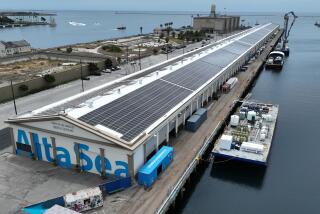Profits Ahoy : Strong Economy and a Hefty Number of Boat Shows Translate Into Millions of Dollars in Sales
- Share via
So you think that boat shows are merely a good excuse to drag the kids out to the marina, contract a first-degree sunburn, and indulge in fantasies of flapping sails and island escapades. Well, think again.
In the retail marine business, the consumer boat show is more than just a weekend dream-a-thon for the landlocked. It is the serious boat dealer’s major sales tool, a marketing ploy that is one part carnival, one part swap meet and one part seafaring auto mall.
It is also the best way for the discriminating shopper to find the dinghy of his or her dreams, finagle a good bargain and get rid of, oh, $300,000, quick.
“Boat shows are the answer, and they’re getting more important every year,” said Ken Kuklish, who sells about $16 million in Sea Ray luxury power boats each year and credits boat shows with half of those sales.
An estimated 200 of these aquatic orgies are planned throughout the country in fiscal year 1989, which is nearly double the number staged a decade ago, according to Matt Kaufman, executive director of the Marine Retailers Assn. of America.
In addition to higher numbers, “there seems to be an increase in the effectiveness of shows as a medium for marketing recreational boating equipment,” Kaufman said. “People seem to wait for the shows to make their final buying commitments.”
And as the boating industry flourishes, marine watchers split the credit between the buoyant economy and the omnipresent boat show. There are major shows in 41 states.
With 17 shows planned for the coming year, California is No. 2 behind Florida in the number of events. But Southern California is the undisputed capital of the state’s boating industry, with more than half of the state’s boating businesses, three-quarters of its boat shows and nearly half of its show producers.
The crown jewel of California’s boat show calendar is probably the 32-year-old Southern California Boat Show, which is staged each February at the Los Angeles Convention Center and is sponsored by the Orange-based Southern California Marine Assn., the state’s top boat show producer.
“The Los Angeles show is the kickoff show, displaying the new models for the first time in California,” said Spike Harvey, the association’s executive director. “There were 1,000 boats there this year . . . and between $50 million and $100 million in sales.”
Bob Swan is the owner of Newport Pacific yacht sales in Newport Beach, a top dealer of pricey Bayliner cruisers, and one of Kuklish’s toughest competitors. The two men figure that together they sold $10 million to $20 million worth of luxury power cruisers at the 1988 Convention Center boat show in February.
In fact, Swan contends that a solid 70% of his estimated $20 million in annual sales comes from the four Southern California shows at which he exhibits. His best performance was perhaps two years ago at the Southern California Marine Assn.’s 1986 American Boating Jubilee in Long Beach.
At that 10-day event, three extravagant skippers sailed away from Swan’s Shoreline Marina exhibit at the helms of 45-foot luxury cruisers. Swan’s total haul for those three sales alone: $720,000.
But then, the haul would have to be hefty, because exhibitors as large as Swan can pay up to $50,000 to participate in a show, Harvey said.
While Southern California’s boat shows have size on their side, Northern California’s have history. The state’s upper half is home to the oldest boat show west of the Mississippi River, the San Francisco Sports & Boat Show.
Although it has grown to fill the Cow Palace and boasts more than 500 boats, “it was a very tiny show when it began in 1942,” said Tom Rooney, the January show’s general manager.
The Japanese “had bombed Pearl Harbor (just before the first San Francisco show) and they thought San Francisco was next to go,” Rooney said. “There were blackouts, air raid sirens and false alarms during the show. Attendance was very tiny, but one interesting man came to the show--an Army lieutenant named Ronald Reagan.”
There is no record of a purchase by that lieutenant, but chances are that his military salary at the time would have hardly covered the price of a yacht, even at 1942 prices.
Today, such a spectator would have some recourse, a way to go home the owner of something new, even if it isn’t one of Swan’s quarter-of-a-million-dollar yachts.
For in addition to boat dealers, most shows have exhibitor-choked midways, where entrepreneurs hope to break into the $16.5-billion national boating industry with everything from anchor-shaped key chains to “reverse osmosis desalination systems” that turn saltwater into fresh.
At the 1988 American Boating Jubilee, which continues in Long Beach until Sunday, those prone to shipwreck can purchase buoyant sunglass straps for a mere $4.50. While the overboard sailor might sink to the bottom, his sunglasses would stay afloat with a neo-propene strap.
For a few bucks more, a seafaring animal lover could buy April Ode’s patent-pending doggie life vest, fitted with sturdy handles to drag a drowning Doberman from the drink.
“If your dog’s in the water and he can’t get back in the boat, all you have to do is grab him,” she said.
More to Read
Inside the business of entertainment
The Wide Shot brings you news, analysis and insights on everything from streaming wars to production — and what it all means for the future.
You may occasionally receive promotional content from the Los Angeles Times.











